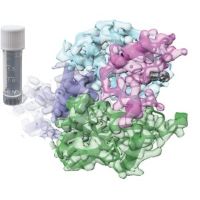Specification
| Description | Recombinant protein from the full-length sequence of Homo sapiens alkB homolog 1, histone H2A dioxygenase (ALKBH1) (NM_006020). |
| Organism | Homo sapiens (Human) |
| Expression Host | Human Cells |
| Tag Info | His or DYKDDDDK. Please contact us if you need further information or require specific designed tag. |
| Purity | Greater than 90% by SDS-PAGE gel |
| Uniprot ID | Q13686 |
| Entry Name | ALKB1_HUMAN |
| Gene Names | ALKBH1 ABH ABH1 ALKBH |
| Alternative Gene Names | ABH ABH1 ALKBH |
| Alternative Protein Names | Nucleic acid dioxygenase ALKBH1 (EC 1.14.11.-) (Alkylated DNA repair protein alkB homolog 1) (Alpha-ketoglutarate-dependent dioxygenase ABH1) (DNA 6mA demethylase) (DNA N6-methyl adenine demethylase ALKBH1) (EC 1.14.11.51) (DNA lyase ABH1) (EC 4.2.99.18) (DNA oxidative demethylase ALKBH1) (EC 1.14.11.33) (mRNA N(3)-methylcytidine demethylase) (EC 1.14.11.-) |
| Application | Antigens, Western, ELISA and other in vitro binding or in vivo functional assays, and protein-protein interaction studies; For research & development use only! |
| Buffer | Purified protein formulated in a sterile solution of PBS buffer, pH7.2, without any preservatives |
| Endotoxin | Endotoxin level is < 0.1 ng/µg of protein (<1EU /µg) |
| Length | 389 |
| Molecular Weight(Da) | 43832 |
| Protein Sequence | (The sequence of expressed protein may have some variation from the sequence shown below. Please contact us for the exact sequence.) MGKMAAAVGSVATLATEPGEDAFRKLFRFYRQSRPGTADLEGVIDFSAAHAARGKGPGAQKVIKSQLNVSSVSEQNAYRAGLQPVSKWQAYGLKGYPGFIFIPNPFLPGYQWHWVKQCLKLYSQKPNVCNLDKHMSKEETQDLWEQSKEFLRYKEATKRRPRSLLEKLRWVTVGYHYNWDSKKYSADHYTPFPSDLGFLSEQVAAACGFEDFRAEAGILNYYRLDSTLGIHVDRSELDHSKPLLSFSFGQSAIFLLGGLQRDEAPTAMFMHSGDIMIMSGFSRLLNHAVPRVLPNPEGEGLPHCLEAPLPAVLPRDSMVEPCSMEDWQVCASYLKTARVNMTVRQVLATDQNFPLEPIEDEKRDISTEGFCHLDDQNSEVKRARINPDS |
Background
| Function | FUNCTION: Dioxygenase that acts as on nucleic acids, such as DNA and tRNA (PubMed:18603530, PubMed:27745969, PubMed:27497299). Requires molecular oxygen, alpha-ketoglutarate and iron (PubMed:18603530, PubMed:27497299). A number of activities have been described for this dioxygenase, but recent results suggest that it mainly acts as on tRNAs and mediates their demethylation or oxidation depending on the context and subcellular compartment (PubMed:27745969, PubMed:27497299). Mainly acts as a tRNA demethylase by removing N(1)-methyladenine from various tRNAs, with a preference for N(1)-methyladenine at position 58 (m1A58) present on a stem loop structure of tRNAs (PubMed:27745969). Acts as a regulator of translation initiation and elongation in response to glucose deprivation: regulates both translation initiation, by mediating demethylation of tRNA(Met), and translation elongation, N(1)-methyladenine-containing tRNAs being preferentially recruited to polysomes to promote translation elongation (PubMed:27745969). In mitochondrion, specifically interacts with mt-tRNA(Met) and mediates oxidation of mt-tRNA(Met) methylated at cytosine(34) to form 5-formylcytosine (f(5)c) at this position (PubMed:27497299). mt-tRNA(Met) containing the f(5)c modification at the wobble position enables recognition of the AUA codon in addition to the AUG codon, expanding codon recognition in mitochondrial translation (PubMed:27497299). Specifically demethylates DNA methylated on the 6th position of adenine (N(6)-methyladenosine) DNA (PubMed:30392959, PubMed:30017583). N(6)-methyladenosine (m6A) DNA is present at some L1 elements in embryonic stem cells and probably promotes their silencing (By similarity). Demethylates mRNAs containing N(3)-methylcytidine modification (PubMed:31188562). Also able to repair alkylated single-stranded DNA by oxidative demethylation, but with low activity (PubMed:18603530). Also has DNA lyase activity and introduces double-stranded breaks at abasic sites: cleaves both single-stranded DNA and double-stranded DNA at abasic sites, with the greatest activity towards double-stranded DNA with two abasic sites (PubMed:19959401). DNA lyase activity does not require alpha-ketboglutarate and iron and leads to the formation of an irreversible covalent protein-DNA adduct with the 5' DNA product (PubMed:19959401, PubMed:23577621). DNA lyase activity is not required during base excision repair and class switch recombination of the immunoglobulin heavy chain during B lymphocyte activation. May play a role in placental trophoblast lineage differentiation (By similarity). {ECO:0000250|UniProtKB:P0CB42, ECO:0000269|PubMed:18603530, ECO:0000269|PubMed:19959401, ECO:0000269|PubMed:23577621, ECO:0000269|PubMed:27497299, ECO:0000269|PubMed:27745969, ECO:0000269|PubMed:30017583, ECO:0000269|PubMed:30392959, ECO:0000269|PubMed:31188562}. |
| Pathway | |
| Protein Families | AlkB family |
| Tissue Specificity |
QC Data
| Note | Please contact us for QC Data |
| Product Image (Reference Only) |  |

